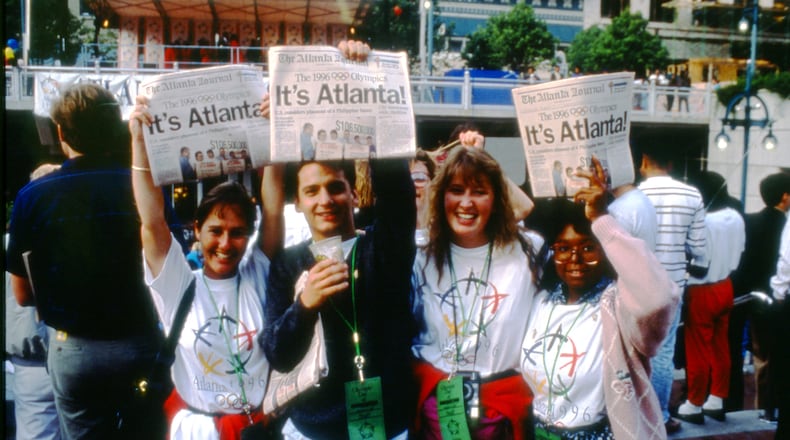There’s a telling quote among the 150 objects, 200 photographs, countless documents and interactive kiosks that make up the new Atlanta History Center exhibit, “Atlanta ’96: Shaping an Olympic and Paralympic City.”
The quote, reprinted on an exhibit wall, dates from a little-remembered effort to win the 1984 Olympics for Atlanta, a bid launched during the 1970s that sputtered and died.
There were many doubters at the time, including a columnist for this newspaper, who wrote in 1977, “It won’t happen now. Not in 1984. Not in your lifetime. Not in mine.”
It turns out the writer was wrong. But his attitude was widespread 10 years later, in 1987, when Atlanta businessman Billy Payne spearheaded yet another effort to win the Games, this time in their centennial year.
Atlanta, up against Toronto, Melbourne, Belgrade, Manchester and (the sentimental favorite) Athens, was an extremely unlikely candidate. When Juan Antonio Samaranch, president of the International Olympic Committee, announced the choice at 9 a.m. on Sept. 18, 1990, the city was thunderstruck.
Legendary sportswriter Furman Bisher wrote an above-the-fold front-page column for that day’s street edition of the Atlanta Journal, with the headline “In ’96 race tortoise again beats the hare.”
Credit: Atlanta History Center
Credit: Atlanta History Center
That sense of shocked happiness is captured in the new exhibit, which will introduce many Atlanta newcomers to the tumultuous days of the Centennial Games.
The history center’s previous Olympics exhibit was disassembled in 2016, during the frenetic construction of the Lloyd and Mary Ann Whitaker Cyclorama Building.
In the course of reinstalling the exhibit, the center re-thought the role of the Games in the life of a city that continues to reinvent itself with regularity. Curator Sarah Dylla interprets the Games in this context: as another opportunity for Atlanta to create a new persona and a place on the national stage.
After the 1996 Games were over, the Georgia Amateur Athletic Foundation made the history center the official steward of the enormous archive of artifacts and documents that traced the history of the effort to win the Games, and the prodigious undertaking of staging the Games.
The exhibit draws from these artifacts, and from donated and borrowed items, including torches from a multitude of past summer Games in cities around the world.
Dylla, 33, has been an Atlanta resident for two years. In 1996 she was a 9-year-old living in Virginia. What she remembers most about the 1996 Olympics was watching TV while U.S. gymnast Kerri Strug landed a double-somersaulting vault on a sprained ankle. Dylla also remembers an Izzy-themed roller coaster at nearby Busch Gardens.
Credit: Stephanie Klein-Davis
Credit: Stephanie Klein-Davis
Sheffield Hale, president and CEO of the Atlanta History Center, said the majority of today’s metro Atlantans arrived after 1996. This group may not know what to make of Izzy, the protean blue blob that was the mascot of the Games.
The exhibit includes a plexiglass vitrine holding an almost-human-sized Izzy, not big enough to wear as a mascot uniform, but close.
Dylla said the history center does, in fact, have a life-sized mascot costume of Izzy, but it hasn’t been washed in 24 years. “I don’t think anybody would want to put that on."
.Another star of the show is represented by a custom-made pair of racing spikes.
In 1996, U.S. sprinter Michael Johnson, employing his distinct upright running posture, won both the 200-meter and 400-meter events, taking home two gold medals. It was the first time a male sprinter had won both events.
The purple shoes Johnson wore during the trials are on display (though not his 3.5-ounce gold shoes with the ceramic aluminum spikes).
Credit: Jeff Najarian
Credit: Jeff Najarian
Visitors facing the cabinet recounting Johnson’s peak experience can turn around and see the story of the Olympic bombing, the lowest point of the Games.
“It’s significant that when you have Michael Johnson in front of you, behind you is the bombing,” said Hale.
On July 27, a 40-pound pipe bomb loaded with nails and screws exploded at Centennial Olympic Park, killing two people. Security guard Richard Jewell was initially listed as a suspect. Three months later Jewell was exonerated, and a year-and-a-half after the bombing, domestic terrorist Eric Rudolph was charged.
(Rudolph remained on the run for seven years and was arrested in 2003. He pled guilty in 2005 and is serving two life sentences.)
The committee of well-connected Atlanta executives led by Payne — often called The Atlanta Nine — who prepared the bid package, went to extraordinary lengths to promote Atlanta as a host. That included creating a video guide to the city, with dramatically-new computer animation. Atlanta asked the upstart film company, Pixar, for help, years before Pixar released its first movie.
On display is one of the Macintosh SE computers that helped in that effort. Its 40-megabyte hard disc was considered advanced.
Like most attractions in Atlanta, the history center has been kayoed by COVID-19. It re-opened to visitors in July, but with stringent safety procedures, including timed tickets, touchless ticketing, plexiglass barriers at admissions and the museum shop, and limited capacity, all to facilitate social distancing.
The 33-acre site seemed almost empty on a recent weekday. Hale said without school groups and bus tours, the center has lost many of its regulars.
EVENT PREVIEW
“Atlanta ’96: Shaping an Olympic and Paralympic City”
Atlanta History Center, 130 W. Paces Ferry Road NW, Atlanta. 404-814-4000, atlantahistorycenter.com.
About the Author
The Latest
Featured






